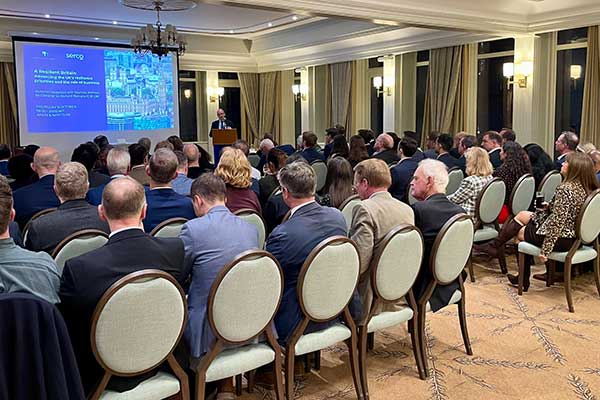By George M. Karagiannis, Engineering Leadership Group Director, Resilience First
Disruptions of critical infrastructure systems and supply chains have spawned some of the most severe, almost iconic, crises in recent history. In today’s globalised economy, infrastructures and supply chains are closely related. Much as infrastructures underpin modern economies, supply chains are the backbone of infrastructure systems. At the same time, supply chains are a linchpin of the modern economy and depend on infrastructure systems to function.
New opportunities and vulnerabilities
This complex nexus of interdependencies between infrastructure and supply chains creates new properties that don’t exist in any one separate system. Recent advances in data science and digital technologies, such as the Internet of Things and Machine Learning, have enabled organisations to leverage these interdependencies to create new opportunities for optimization. IBM estimates that a typical supply chain uses 50 times more data today than it did five years ago.
However, the vast interdependencies among infrastructure and supply chains also create vulnerabilities stemming from cascading failures, which occur when a disruption in one system deprives another system of its required inputs or support services. For instance, unusually hot and dry weather in Europe in 2020 reduced the water level of the Rhine, a major navigable waterway crossing most of Central Europe. This led to delays across all supply chains using the river, including that for coal, which ultimately increased the risk to coal-fired electricity generation in that part of the world.
The combination of globalisation and climate change is rapidly changing the resilience landscape for infrastructure systems and supply chains. As world trade increases with globalisation and vice versa, the interdependencies between supply chains and infrastructure systems become wider in scope and deeper in substance. In addition, climate change is increasing the risk from weather-related natural disasters and creates additional long-term stressors for infrastructure operators and supply chains alike. Disruptions are becoming more frequent and more severe. And although the just-in-time approach has helped supply chains become more efficient, but this often is at the expense of the reserve capacity much needed in a disrupting event.
A perfect storm
As the supply chain crisis spawned by COVID-19 abates, we only need to look as far as the microchip industry to be reminded of the complex relationship between infrastructure and supply chains. The pandemic severely disrupted the semiconductor chip supply chain, leading to a worldwide shortage. This is almost a textbook perfect storm, caused by a congruence of several factors. First, demand for microchips surged rapidly during the pandemic: workers and students needed more personal computers and other consumer electronics due to an increase in remote work and learning, hospitals needed more medical devices to manage COVID-19 cases, and consumers bought more new cars in the early recovery phase. At the same time, a series of hazards and threats affected critical nodes of the microchip supply chain around the world. Power outages caused by a severe winter storm in Texas forced three semiconductor chip manufacturing plants to temporarily halt operations, two more factories caught fire, and a drought in Taiwan has reduced the output of the world’s largest chip manufacturer. And the supply of neon, a noble gas needed for lasers used in the production of semiconductor chips, has been severely affected by the conflict between Russia and Ukraine, as the latter produces about half of the world’s neon supply.
What does this mean for organisational resilience?
Infrastructures are private entities supplying public goods, a process usually involving complex supply chains. Therefore, achieving resilience of infrastructures and supply chains will require a whole-community approach involving governments, regulators, infrastructure operators and the organisations that make up critical supply chains.
Governments need to establish resilience standards and minimum requirements. To accomplish this, communities should begin by establishing the level of infrastructure and supply chain resilience they are willing to accept, and the budget required to achieve it. This will probably be a difficult political decision between uncomfortable alternatives, but one that communities should have sooner rather than later. Policies need to incentivize resilience investment, which tends to suffer from the low probability of hazards and threats and the cost structure of risk reduction projects.
Furthermore, infrastructure and supply chain resilience needs a risk-driven, comprehensive approach. Sound risk management helps stakeholders assign priorities and resources. Detailed mapping of supply chains is crucial to understanding the interdependencies between infrastructure systems and supply chains. Stress-testing helps to identify vulnerabilities, anticipate future disruptions, and guide resilience strategies. In the perfect storm that COVID-19 constituted for the global microchip supply chain, Toyota fared the shortage better than rival automakers, arguably thanks to its long-time strategy of working closely with its suppliers and an in-depth knowledge of the firm’s supply chain.
A comprehensive approach considers all hazards and threats facing infrastructure and supply chains; encompasses mitigation, preparedness, response, and recovery, addresses all potential impacts; and involves all stakeholders. Consensus and unity of effort are needed to synchronize the activities of all levels of government and all elements of a community to achieve a common purpose. Regulators need explicit authority to oversee resilience strategies adopted by the private sector across supply chains.
The balance between efficiency and resilience need not be a zero-sum game.
In the face of a volatile operating environment, fraught with uncertainty, resilience creates opportunities for organisations to persevere against growing hazards and threats to supply chains and infrastructure.



